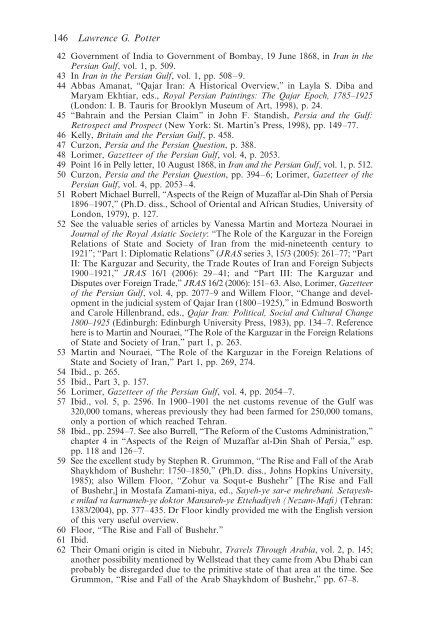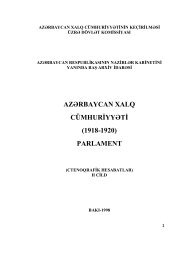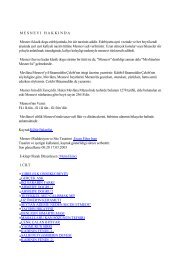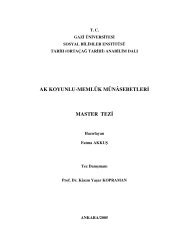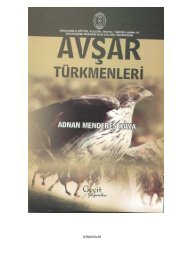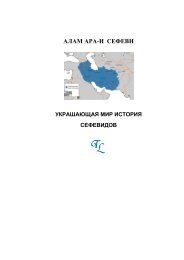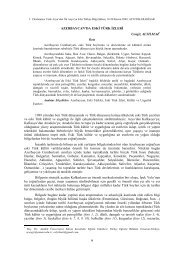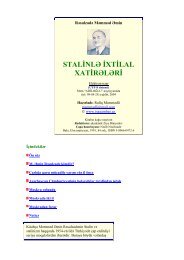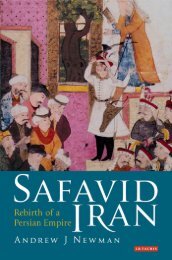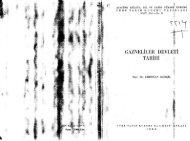Consolidation of Iran’s frontier 14523 There is an extensive literature on the Qawasim. The most thorough treatmentis Charles E. Davies, The Blood-Red Arab Flag: An Investigation <strong>in</strong>to Qasimi Piracy1797–1820 (Exeter: University of Exeter Press, 1997); see also Sultan Mohammadal-Qasimi, The Myth of Arab Piracy <strong>in</strong> the Gulf, 2nd edn. (London: Routledge,1988).24 Perry, Karim Khan Z<strong>and</strong>, p. 152.25 Lorimer, G<strong>az</strong>etteer of the <strong>Persia</strong>n Gulf, vol. 8, pp. 754–5.26 Assem Dessouki, “Social <strong>and</strong> Political Dimensions of the Historiography of theArab Gulf,” <strong>in</strong> Eric Davis <strong>and</strong> Nicolas Gavrielides, eds, Statecraft <strong>in</strong> the MiddleEast: Oil, Historical Memory, <strong>and</strong> Popular Culture (Miami: Florida InternationalUniversity Press, 1991), pp. 92–115. The hawla were noted for be<strong>in</strong>g anti-British.Also, Anie Montigny, “Les Arabes de l’Autre Rive,” Cahiers d’études sur laMéditerranée orientale et le monde turco-iranien 22 (Juillet–Décembre 1996): 51–81.27 See here Beatrice Nicol<strong>in</strong>i, Makran, Oman <strong>and</strong> Zanzibar: Three-Term<strong>in</strong>alCultural Corridor <strong>in</strong> the Western Indian Ocean (1799–1856), trans. Penelope-JaneWatson (Leiden: Brill, 2004); also Calv<strong>in</strong> H. Allen, Jr, “The State of Masqat <strong>in</strong>the Gulf <strong>and</strong> East Africa, 1785–1829,” International Journal of Middle East Studies14/2 (May 1982): 117–27.28 M<strong>in</strong>istry of Information, Sultanate of Oman, Oman <strong>in</strong> History (London: ImmelPublish<strong>in</strong>g, 1995), p. 348.29 Lorimer, G<strong>az</strong>etteer of the <strong>Persia</strong>n Gulf, vol. 2, p. 602.30 The nature of this grant has been disputed ever s<strong>in</strong>ce. Kalat ma<strong>in</strong>ta<strong>in</strong>ed that thegrant was only for the temporary support of the sultan while he was a refugee,whereas Oman contends that the cession was permanent <strong>and</strong> assured navalprotection of the Makran coast. In any case, Gwadar thrived under Omanisovereignty <strong>and</strong> became the ma<strong>in</strong> port on the Makran coast. Oman ma<strong>in</strong>ta<strong>in</strong>edpossession of Gwadar until it sold it to Pakistan <strong>in</strong> 1958. (More detail <strong>in</strong>Lorimer, G<strong>az</strong>etteer of the <strong>Persia</strong>n Gulf, vol. 2, pp. 601–22). See also RiccardoRedaelli, “Adm<strong>in</strong>istrative Subdivisions <strong>and</strong> Tribal Structures: The Perception ofTerritory between Tradition <strong>and</strong> Modernity,” <strong>in</strong> Baluchistan: Terra Incognita:A New Methodological Approach Comb<strong>in</strong><strong>in</strong>g Archaeological, Historical, Anthropological<strong>and</strong> Architectural Studies, BAR International Series 1141, Studies <strong>in</strong> theArchaeology <strong>and</strong> History of Baluchistan 1 (Oxford: Archaeopress, 2003), pp. 37–8.31 For an annual payment of 6,000 tomans B<strong>and</strong>ar Abbas thus became a dependencyof Oman. See Kelly, Brita<strong>in</strong> <strong>and</strong> the <strong>Persia</strong>n Gulf, pp. 13 <strong>and</strong> 184–5; alsoS. B. Miles, The Countries <strong>and</strong> Tribes of the <strong>Persia</strong>n Gulf (London: Harrison <strong>and</strong>Sons, 1919; repr<strong>in</strong>t Read<strong>in</strong>g: Garnet Publish<strong>in</strong>g, 1994), pp. 286–7.32 Allen, “The State of Masqat <strong>in</strong> the Gulf <strong>and</strong> East Africa,” p. 119. Most of thiscame from salt m<strong>in</strong>ed <strong>in</strong> Hormuz.33 Accord<strong>in</strong>g to Omani historians. M<strong>in</strong>istry of Information, Oman <strong>in</strong> History, pp. 483–4.34 Briton Cooper Busch, Brita<strong>in</strong> <strong>and</strong> the <strong>Persia</strong>n Gulf, 1894–1914 (Berkeley:University of California Press, 1967), pp. 6–10.35 James Onley, “Brita<strong>in</strong>’s Native Agents <strong>in</strong> Arabia <strong>and</strong> <strong>Persia</strong> <strong>in</strong> the N<strong>in</strong>eteenthCentury,” Comparative Studies of South Asia, Africa <strong>and</strong> the Middle East 24/1(Spr<strong>in</strong>g 2004): 129–37.36 Curzon, <strong>Persia</strong> <strong>and</strong> the <strong>Persia</strong>n Question, p. 398.37 Lorimer, G<strong>az</strong>etteer of the <strong>Persia</strong>n Gulf, vol. 4, p. 1981.38 Ibid., pp. 2105–9. The Union Jack was flown there.39 For a useful account of the second British attack <strong>and</strong> occupation, see “The <strong>Persia</strong>n<strong>War</strong>, 1856–1857,” Chapter 11 <strong>in</strong> Kelly, Brita<strong>in</strong> <strong>and</strong> the <strong>Persia</strong>n Gulf, pp. 452–99.40 In Iran <strong>in</strong> the <strong>Persia</strong>n Gulf 1820–1966, research editors A. L. P. Burdett <strong>and</strong> A.Seay [British Diplomatic Documents] (Farnham Common: Archive Editions, 2000),vol. 1, pp. 743–5.41 Kelly, Brita<strong>in</strong> <strong>and</strong> the <strong>Persia</strong>n Gulf, p. 475.
146 Lawrence G. Potter42 Government of India to Government of Bombay, 19 June 1868, <strong>in</strong> Iran <strong>in</strong> the<strong>Persia</strong>n Gulf, vol. 1, p. 509.43 In Iran <strong>in</strong> the <strong>Persia</strong>n Gulf, vol. 1, pp. 508–9.44 Abbas Amanat, “<strong>Qajar</strong> Iran: A Historical Overview,” <strong>in</strong> Layla S. Diba <strong>and</strong>Maryam Ekhtiar, eds., Royal <strong>Persia</strong>n Pa<strong>in</strong>t<strong>in</strong>gs: The <strong>Qajar</strong> Epoch, 1785–1925(London: I. B. Tauris for Brooklyn Museum of Art, 1998), p. 24.45 “Bahra<strong>in</strong> <strong>and</strong> the <strong>Persia</strong>n Claim” <strong>in</strong> John F. St<strong>and</strong>ish, <strong>Persia</strong> <strong>and</strong> the Gulf:Retrospect <strong>and</strong> Prospect (New York: St. Mart<strong>in</strong>’s Press, 1998), pp. 149–77.46 Kelly, Brita<strong>in</strong> <strong>and</strong> the <strong>Persia</strong>n Gulf, p. 458.47 Curzon, <strong>Persia</strong> <strong>and</strong> the <strong>Persia</strong>n Question, p. 388.48 Lorimer, G<strong>az</strong>etteer of the <strong>Persia</strong>n Gulf, vol. 4, p. 2053.49 Po<strong>in</strong>t 16 <strong>in</strong> Pelly letter, 10 August 1868, <strong>in</strong> Iran <strong>and</strong> the <strong>Persia</strong>n Gulf, vol. 1, p. 512.50 Curzon, <strong>Persia</strong> <strong>and</strong> the <strong>Persia</strong>n Question, pp. 394–6; Lorimer, G<strong>az</strong>etteer of the<strong>Persia</strong>n Gulf, vol. 4, pp. 2053–4.51 Robert Michael Burrell, “Aspects of the Reign of Muzaffar al-D<strong>in</strong> Shah of <strong>Persia</strong>1896–1907,” (Ph.D. diss., School of Oriental <strong>and</strong> African Studies, University ofLondon, 1979), p. 127.52 See the valuable series of articles by Vanessa Mart<strong>in</strong> <strong>and</strong> Morteza Nouraei <strong>in</strong>Journal of the Royal Asiatic Society: “The Role of the Karguzar <strong>in</strong> the ForeignRelations of State <strong>and</strong> Society of Iran from the mid-n<strong>in</strong>eteenth century to1921”; “Part 1: Diplomatic Relations” (JRAS series 3, 15/3 (2005): 261–77; “PartII: The Karguzar <strong>and</strong> Security, the Trade Routes of Iran <strong>and</strong> Foreign Subjects1900–1921,” JRAS 16/1 (2006): 29–41; <strong>and</strong> “Part III: The Karguzar <strong>and</strong>Disputes over Foreign Trade,” JRAS 16/2 (2006): 151–63. Also, Lorimer, G<strong>az</strong>etteerof the <strong>Persia</strong>n Gulf, vol. 4, pp. 2077–9 <strong>and</strong> Willem Floor, “Change <strong>and</strong> development<strong>in</strong> the judicial system of <strong>Qajar</strong> Iran (1800–1925),” <strong>in</strong> Edmund Bosworth<strong>and</strong> Carole Hillenbr<strong>and</strong>, eds., <strong>Qajar</strong> Iran: Political, Social <strong>and</strong> Cultural Change1800–1925 (Ed<strong>in</strong>burgh: Ed<strong>in</strong>burgh University Press, 1983), pp. 134–7. Referencehere is to Mart<strong>in</strong> <strong>and</strong> Nouraei, “The Role of the Karguzar <strong>in</strong> the Foreign Relationsof State <strong>and</strong> Society of Iran,” part 1, p. 263.53 Mart<strong>in</strong> <strong>and</strong> Nouraei, “The Role of the Karguzar <strong>in</strong> the Foreign Relations ofState <strong>and</strong> Society of Iran,” Part 1, pp. 269, 274.54 Ibid., p. 265.55 Ibid., Part 3, p. 157.56 Lorimer, G<strong>az</strong>etteer of the <strong>Persia</strong>n Gulf, vol. 4, pp. 2054–7.57 Ibid., vol. 5, p. 2596. In 1900–1901 the net customs revenue of the Gulf was320,000 tomans, whereas previously they had been farmed for 250,000 tomans,only a portion of which reached Tehran.58 Ibid., pp. 2594–7. See also Burrell, “The Reform of the Customs Adm<strong>in</strong>istration,”chapter 4 <strong>in</strong> “Aspects of the Reign of Muzaffar al-D<strong>in</strong> Shah of <strong>Persia</strong>,” esp.pp. 118 <strong>and</strong> 126–7.59 See the excellent study by Stephen R. Grummon, “The Rise <strong>and</strong> Fall of the ArabShaykhdom of Bushehr: 1750–1850,” (Ph.D. diss., Johns Hopk<strong>in</strong>s University,1985); also Willem Floor, “Zohur va Soqut-e Bushehr” [The Rise <strong>and</strong> Fallof Bushehr,] <strong>in</strong> Mostafa Zamani-niya, ed., Sayeh-ye sar-e mehrebani. Setayeshemilad va karnameh-ye doktor Mansureh-ye Ettehadiyeh (Nezam-Mafi) (Tehran:1383/2004), pp. 377–435. Dr Floor k<strong>in</strong>dly provided me with the English versionof this very useful overview.60 Floor, “The Rise <strong>and</strong> Fall of Bushehr.”61 Ibid.62 Their Omani orig<strong>in</strong> is cited <strong>in</strong> Niebuhr, Travels Through Arabia, vol. 2, p. 145;another possibility mentioned by Wellstead that they came from Abu Dhabi canprobably be disregarded due to the primitive state of that area at the time. SeeGrummon, “Rise <strong>and</strong> Fall of the Arab Shaykhdom of Bushehr,” pp. 67–8.
- Page 2 and 3:
War and Peace in Qajar PersiaPersia
- Page 4 and 5:
War and Peace inQajar PersiaImplica
- Page 6 and 7:
ContentsList of figuresContributors
- Page 8 and 9:
Figures5.1 Omani enclaves 1305.2 Ar
- Page 10 and 11:
Contributor listMansoureh Ettehadie
- Page 12:
AcknowledgementsThis volume grew ou
- Page 15 and 16:
2 Roxane Farmanfarmaianrepresented
- Page 17 and 18:
4 Roxane Farmanfarmaianchapter in t
- Page 19 and 20:
6 Roxane FarmanfarmaianThus, two si
- Page 21 and 22:
8 Roxane Farmanfarmaiangaining grea
- Page 23 and 24:
10 Roxane Farmanfarmaiantough deals
- Page 25 and 26:
12 Roxane FarmanfarmaianIranian geo
- Page 27 and 28:
14 Peter W. Averyin Shiraz and cont
- Page 29 and 30:
16 Peter W. Averybut the invasion w
- Page 32:
Part IWar
- Page 35 and 36:
22 Manoutchehr M. Eskandari-Qajarth
- Page 37 and 38:
24 Manoutchehr M. Eskandari-Qajarap
- Page 39 and 40:
26 Manoutchehr M. Eskandari-Qajarmi
- Page 41 and 42:
28 Manoutchehr M. Eskandari-Qajarth
- Page 43 and 44:
30 Manoutchehr M. Eskandari-Qajardo
- Page 45 and 46:
32 Manoutchehr M. Eskandari-QajarIn
- Page 47 and 48:
34 Manoutchehr M. Eskandari-Qajarco
- Page 49 and 50:
36 Manoutchehr M. Eskandari-QajarTh
- Page 51 and 52:
38 Manoutchehr M. Eskandari-Qajarth
- Page 53 and 54:
40 Manoutchehr M. Eskandari-Qajarth
- Page 55 and 56:
42 Manoutchehr M. Eskandari-Qajarop
- Page 57 and 58:
44 Manoutchehr M. Eskandari-Qajarbe
- Page 59 and 60:
46 Manoutchehr M. Eskandari-Qajarva
- Page 61 and 62:
48 Stephanie Cronincapacity and res
- Page 63 and 64:
50 Stephanie Croninforces of the es
- Page 65 and 66:
52 Stephanie CroninPART ONE: THE QA
- Page 67 and 68:
54 Stephanie Croninprincipally on h
- Page 69 and 70:
56 Stephanie CroninThe French offic
- Page 71 and 72:
58 Stephanie CroninEuropean alignme
- Page 73 and 74:
60 Stephanie Croninthe authorities
- Page 75 and 76:
62 Stephanie Croninin the revolutio
- Page 77 and 78:
64 Stephanie Croninof power and sta
- Page 79 and 80:
66 Stephanie Croninliving and the m
- Page 81 and 82:
68 Stephanie Croninconsequences for
- Page 83 and 84:
70 Stephanie Croninrevolution was a
- Page 85 and 86:
72 Stephanie CroninNew British miss
- Page 87 and 88:
74 Stephanie CroninBrigade to a Div
- Page 89 and 90:
76 Stephanie Croninwithout the sove
- Page 91 and 92:
78 Stephanie Croninaccounting devic
- Page 93 and 94:
80 Stephanie Croninbut also faced a
- Page 95 and 96:
82 Stephanie Cronindetermined on th
- Page 97 and 98:
84 Stephanie Cronin15 For a discuss
- Page 99 and 100:
86 Stephanie Cronin55 The Anglo-Rus
- Page 101 and 102:
3 The Turko-Persian War1821-1823Win
- Page 103 and 104:
90 Graham WilliamsonThe resultant w
- Page 105 and 106:
92 Graham Williamsonprovincial forc
- Page 107 and 108: 94 Graham WilliamsonThe field armyO
- Page 109 and 110: 96 Graham Williamsonnot hold out mu
- Page 111 and 112: 98 Graham Williamsonoften in arrear
- Page 113 and 114: 100 Graham Williamsonthan any desig
- Page 115 and 116: 102 Graham WilliamsonThere were ove
- Page 117 and 118: 104 Graham Williamsonone should not
- Page 119 and 120: Table 3.2 Persian regional armies (
- Page 121 and 122: 108 Graham WilliamsonIranian influe
- Page 123 and 124: 4 Social networks andborder conflic
- Page 125 and 126: 112 Vanessa MartinPersian troops on
- Page 127 and 128: 114 Vanessa Martinof comparatively
- Page 129 and 130: 116 Vanessa MartinTHE ROLE OF SOCIA
- Page 131 and 132: 118 Vanessa MartinThe Shah’s negl
- Page 133 and 134: 120 Vanessa Martinborder or any oth
- Page 135 and 136: 122 Vanessa Martin44 No. 38, 2 June
- Page 138 and 139: 5 The consolidation of Iran’sfron
- Page 140 and 141: Consolidation of Iran’s frontier
- Page 142 and 143: Consolidation of Iran’s frontier
- Page 144 and 145: Consolidation of Iran’s frontier
- Page 146 and 147: Consolidation of Iran’s frontier
- Page 148 and 149: Consolidation of Iran’s frontier
- Page 150 and 151: Figure 5.2 Arab principalities
- Page 152 and 153: Consolidation of Iran’s frontier
- Page 154 and 155: Consolidation of Iran’s frontier
- Page 156 and 157: Consolidation of Iran’s frontier
- Page 160 and 161: Consolidation of Iran’s frontier
- Page 162 and 163: 6 Narrowing the frontierMid-ninetee
- Page 164 and 165: Narrowing the frontier 151witnessed
- Page 166 and 167: Figure 6.1 The 1843 borderlands sta
- Page 168 and 169: Narrowing the frontier 155And the S
- Page 170 and 171: Figure 6.2 The 1850 Williams line a
- Page 172 and 173: Narrowing the frontier 159elicited
- Page 174 and 175: Narrowing the frontier 161travellin
- Page 176 and 177: Narrowing the frontier 163be found
- Page 178 and 179: Narrowing the frontier 165A similar
- Page 180 and 181: Narrowing the frontier 167and accep
- Page 182 and 183: Narrowing the frontier 169Perhaps t
- Page 184 and 185: Narrowing the frontier 171By this s
- Page 186 and 187: Narrowing the frontier 17346 For a
- Page 188 and 189: Crime, security, and insecurity 175
- Page 190 and 191: Crime, security, and insecurity 177
- Page 192 and 193: Crime, security, and insecurity 179
- Page 194 and 195: Crime, security, and insecurity 181
- Page 196 and 197: 8 Merchants without bordersTrade, t
- Page 198 and 199: Merchants without frontier 185the m
- Page 200 and 201: Merchants without frontier 187and d
- Page 202 and 203: Merchants without frontier 189photo
- Page 204 and 205: Merchants without frontier 191their
- Page 206 and 207: Merchants without frontier 193In an
- Page 208 and 209:
Figure 8.1Seated, first from left:
- Page 210 and 211:
Figure 8.3Seated: Hajj Mohammad-Taq
- Page 212 and 213:
Figure 8.5 Taken in Hajj Hasan Jour
- Page 214 and 215:
Merchants without frontier 201Figur
- Page 216 and 217:
Merchants without frontier 203Studi
- Page 218 and 219:
Merchants without frontier 20516 Me
- Page 220 and 221:
Merchants without frontier 207and t
- Page 222 and 223:
Merchants without frontier 209or pu
- Page 224 and 225:
Merchants without frontier 211It ca
- Page 226 and 227:
9 The politics of concessionReasses
- Page 228 and 229:
The politics of concession 215gradu
- Page 230 and 231:
The politics of concession 217Shah,
- Page 232 and 233:
The politics of concession 219assig
- Page 234 and 235:
The politics of concession 221compa
- Page 236 and 237:
The politics of concession 223gross
- Page 238 and 239:
The politics of concession 225the B
- Page 240 and 241:
The politics of concession 227as th
- Page 242 and 243:
IndexAbbas Mirza, Crown Prince 6, 1
- Page 244 and 245:
Index 231Gulf Arabs 127-9Gwadar 136
- Page 246 and 247:
Index 233policy in Persian Gulf 131


